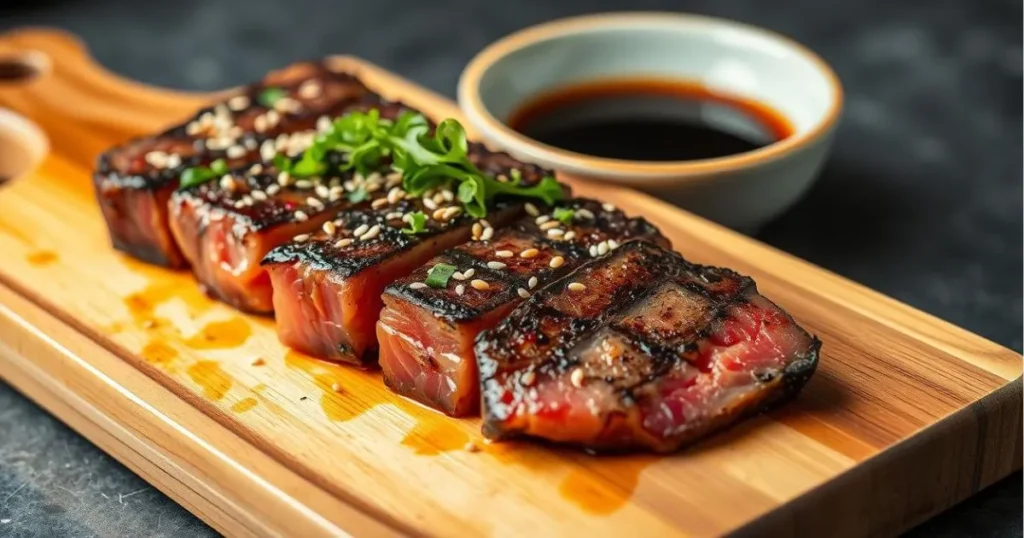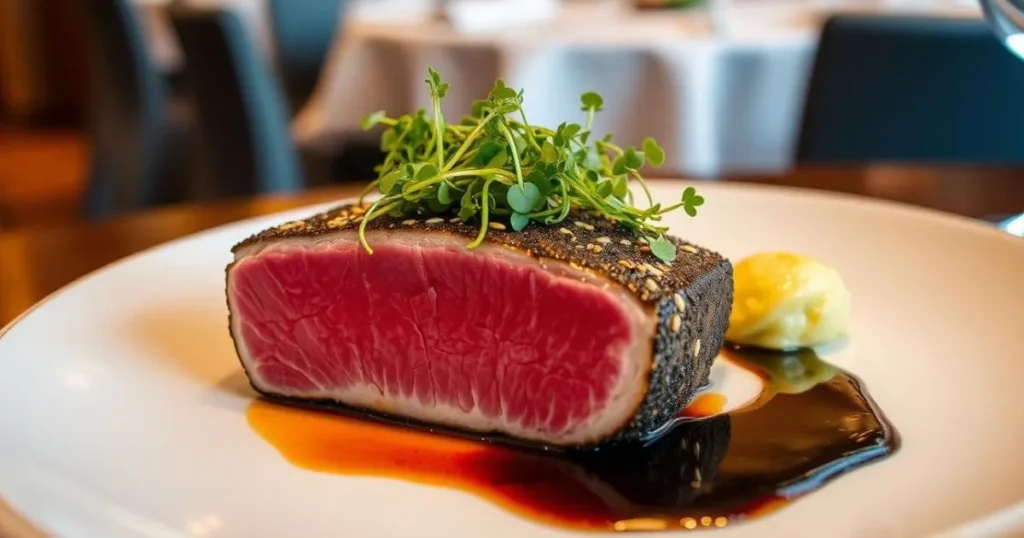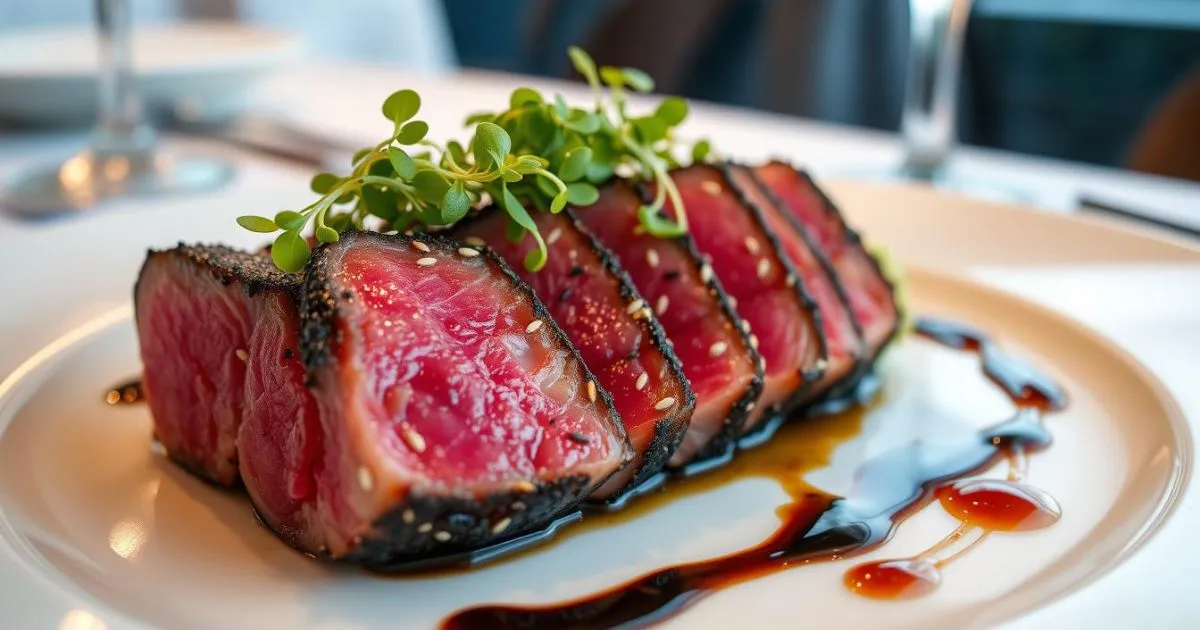Ahi tuna recipe seared
Table of Contents
As the sun set, it painted the sky with orange and gold. I was in my kitchen, watching fresh ahi tuna steaks sizzle. The smell of toasted sesame oil and soy sauce reminded me of Tokyo’s busy streets.
In Tokyo, seared tuna was a favorite lunch for many. In that moment, I knew I had to share this dish with you. It’s a treat that can make any meal special.
Seared ahi tuna is a true delicacy. It has a crispy outside and a soft inside. This recipe will help you make a dish like a restaurant’s at home.
Understanding Sushi-Grade Ahi Tuna
Preparing top-notch sashimi-grade tuna dishes requires knowing the differences between ahi tuna types. The main species are yellowfin (Thunnus albacares) and bigeye (Thunnus obesus). Yellowfin tuna is known for its mild, sweet taste and pink flesh. It’s perfect for sushi, sashimi, and seared tuna steaks.
Bigeye tuna, however, has a richer flavor and more fat. It’s great for poke bowls and sashimi.
Where to Source Quality Tuna
To get the freshest, safest sashimi-grade tuna, find reliable suppliers. Check out grocery stores with sushi departments, seafood markets, or online shops focused on sashimi-grade tuna. When buying tuna, look for vibrant color, firm texture, and a fresh smell. These signs mean the tuna is of high quality.
Safety Guidelines for Raw Fish
Eating raw fish like tuna sashimi or poke needs careful food safety. Always use your best judgment. If unsure, talk to a healthcare expert, especially for pregnant women or those with weak immune systems. Following proper handling, storage, and preparation of yellowfin tuna recipes ensures a safe, enjoyable meal.
Essential Ingredients for ahi tuna recipe seared
Making the perfect seared ahi tuna dish begins with choosing the right ingredients. You need sushi-grade ahi tuna steaks, a tasty marinade, and a crunchy sesame seed crust.
The marinade mix includes soy sauce (or liquid aminos for a gluten-free option), toasted sesame oil, grated ginger, minced garlic, sliced scallions, and a bit of fresh lime juice. This blend gives the tuna a unique Asian taste.
To get the sesame-crusted texture, use a mix of black and white sesame seeds. Add granulated garlic or onion powder, kosher salt, fresh cracked pepper, a pinch of sugar, and a sprinkle of dried thyme or Italian seasoning.
With these key ingredients, you’re ready to make a delicious ahi tuna marinade and sesame-crusted tuna. This dish will surely wow your guests. Now, let’s move on to the step-by-step guide for making it.

Preparing Your Tuna Steaks
Get ready to make a delicious ahi tuna recipe seared to perfection! The right preparation is crucial for the perfect texture and taste. First, thaw your tuna steaks. You can thaw them in cold water or in the fridge overnight.
After thawing, pat the steaks dry with paper towels. This step is important for a great sear.
Creating the Perfect Marinade
Now, let’s make a tasty marinade. Mix soy sauce, sesame oil, minced ginger, garlic, scallions, and lime juice in a dish. Add your tuna steaks, making sure they’re coated well.
Then, cover and refrigerate for at least an hour. This lets the tuna soak up the flavors.
Seasoning Techniques
Next, season your tuna steaks. In a bowl, mix sesame seeds, garlic powder, salt, pepper, sugar, and dried herbs. Coat the tuna on all sides with this blend, pressing it in.
This savory crust will elevate your tuna sear!
With your tuna prepped and seasoned, you’re ready for the searing process. Now, you can make a top-notch ahi tuna dish in your kitchen.
The Perfect Sesame Crust Coating
Take your sesame-crusted tuna and ahi tuna recipe seared to the next level with a tasty sesame crust. This crust not only adds a nice crunch but also keeps the tuna juicy and tender.
To make the perfect sesame crust, mix toasted and black sesame seeds for color and texture. Add granulated garlic or onion powder, salt, pepper, sugar, and dried thyme or Italian seasoning. The sugar helps the crust turn golden quickly, preventing overcooking.
After marinating the tuna, coat the steaks with the sesame seed mix. Press it firmly into the flesh on all sides. This creates a crispy, flavorful outside that matches the tender, seared inside of the fish.
| Ingredient | Quantity |
|---|---|
| Toasted Sesame Seeds | 2 tablespoons |
| Black Sesame Seeds | 2 tablespoons |
| Granulated Garlic or Onion Powder | 1 teaspoon |
| Salt | 1/2 teaspoon |
| Black Pepper | 1/4 teaspoon |
| Granulated Sugar | 1 teaspoon |
| Dried Thyme or Italian Seasoning | 1/2 teaspoon |
Creating the perfect sesame-crusted tuna is easy. Enjoy the bold flavors and textures of this amazing coating. It will take your ahi tuna recipe seared to new heights.

Mastering the Searing Technique
Getting the perfect sear on your tuna steak is key to a great dish. With a few simple steps, you can bring out the flavors and textures of your seared tuna steaks. Let’s explore the secrets to a great sear.
Pan Selection and Heat Control
Choose a cast-iron skillet or a well-seasoned stainless steel pan for the best sear. These pans hold heat well, giving you a consistent sear. Heat your pan over medium-high for 2-3 minutes until it’s very hot. This high heat is essential for a golden-brown crust.
Timing Your Sear
Timing is crucial when searing your tuna steak. Rare tuna should be seared for 30-45 seconds per side. Medium-rare tuna needs 60 seconds per side. Slice your tuna thinly against the grain for the best texture.
Place the tuna in the hot pan and sear each side. Use tongs to sear the edges for an even crust.
Visual Cues for Doneness
Watch for visual cues to get your seared tuna steaks just right. Look for a golden-brown outside and a red, raw inside for rare to medium-rare tuna. Adjust cooking time based on tuna thickness and your preference. Remember, the tuna will cook a bit more while resting, so aim for a slightly rarer doneness.
With these tips, you’ll master searing tuna steaks and impress everyone. Enjoy the juicy, perfectly cooked tuna and the contrast of the seared outside and rare inside.
Serving Suggestions and Pairings
Take your seared ahi tuna to the next level with tasty serving ideas and pairings. Whether you want a classic Japanese dish or a light, healthy option, there are many ways to enjoy your seared tuna. Each choice brings out the rich, savory taste of your tuna steaks.
For a traditional taste, serve your ahi tuna with fluffy white rice, radish sprouts, nori slivers, and sesame seeds. This mix of textures and flavors highlights the fish’s natural taste.
Try a ahi poke bowl for a fresh meal. Cube the tuna and place it on a bed of greens. Add an Asian dressing for a light touch. Serve with a cool Asian cucumber salad and Japanese rice with furikake for a Hawaiian vibe.
For something different, put seared ahi tuna slices on avocado toast or mix it into a tuna salad. Top with scallions and a squeeze of lime for extra flavor.
There are countless ways to serve your seared ahi tuna. Try new combinations to find your favorite way to enjoy this seafood gem.

Storage and Handling Tips
Storing and handling your ahi tuna recipe seared right is key to keeping it fresh and tasty. Here are some tips to keep your seared tuna steaks as delicious as the first time you had them.
Proper Storage Methods
After enjoying your seared ahi tuna, any leftovers should go in an airtight container in the fridge for up to 24 hours. This keeps the tuna’s texture and stops it from drying out. You can eat it cold or at room temperature, making it great for later meals.
Freezing leftover seared ahi tuna isn’t a good idea, as it can ruin the fish’s texture and quality. For uncooked tuna, keep it in the coldest part of your fridge and eat it within 1-2 days.
Leftover Management
- Store leftover seared ahi tuna in an airtight container in the refrigerator for up to 24 hours.
- Enjoy the seared tuna cold or at room temperature – it’s a versatile option for future meals.
- Avoid freezing leftover seared tuna, as it may affect the texture.
- For uncooked portions, store in the coldest part of the refrigerator and consume within 1-2 days.
- Always use clean utensils and surfaces when handling raw fish to prevent cross-contamination.
By sticking to these storage and handling tips, your ahi tuna recipe seared and seared tuna steaks will stay fresh and tasty. You’ll be ready to enjoy them whenever you want.
Health Benefits and Nutritional Information
Discover the wonders of yellowfin tuna and take your cooking to new heights. This fish is not just tasty but also packed with nutrients. A 4-ounce serving of ahi tuna has 236 calories, 29.1g of protein, and 10.7g of healthy fats.
This makes it perfect for keeping your weight in check and repairing muscles. Ahi tuna is also a treasure trove of omega-3 fatty acids. These fats are key in fighting inflammation and keeping your heart healthy.
Adding ahi tuna to your meals, like in a salad, can be a tasty way to get more of these nutrients. This supports your overall health and well-being.
While ahi tuna is generally safe, it’s crucial to watch out for mercury levels. This is especially true for pregnant women and young kids. To help remove mercury, try adding chlorella, cilantro, parsley, or charcoal tablets to your diet.
Always talk to a healthcare expert for advice on what’s best for you. Embrace ahi tuna’s versatility and nutritional benefits. Let it be your guide to a more flavorful and healthy cooking journey.
FAQ
How long does it take to cook seared ahi tuna steaks?
Seared ahi tuna steaks (yellowfin or bigeye tuna) cook in just six minutes. They reach medium-rare perfection quickly.
What is the difference between yellowfin and bigeye tuna?
Yellowfin and bigeye tuna are both ahi tuna species. They taste and feel similar. Ahi tuna is often cheaper than bluefin tuna.
Where can I find high-quality, sushi-grade tuna?
You can find quality tuna at grocery stores with sushi departments, sushi restaurants, and online. Saku tuna, a block of frozen, vacuum-packed yellowfin tuna, is great for sushi.
Is it safe to eat raw tuna?
Raw tuna is safe if it’s sushi-grade or sashimi-grade. It’s flash-frozen to kill bacteria. Always use your best judgment and follow safety tips, especially for pregnant women or those with health concerns.
What are the key ingredients for seared ahi tuna?
You’ll need sushi-grade ahi tuna steaks, soy sauce or liquid aminos, and high-heat oil. Also, sesame seeds, garlic or onion powder, kosher salt, fresh cracked pepper, sugar, and dried thyme or Italian seasoning.
How do I prepare the tuna steaks before searing?
Thaw the tuna steaks in cold water or in the fridge overnight. Pat them dry and season. Make a marinade with soy sauce, sesame oil, ginger, garlic, scallions, and lime juice. Let the tuna marinate for at least an hour.
What is the purpose of the sesame crust coating?
The sesame crust adds flavor and texture. It’s made with sesame seeds, garlic or onion powder, salt, pepper, sugar, and herbs. The sugar helps get a golden crust faster, preventing overcooking.
How do I properly sear the tuna steaks?
Use a cast-iron skillet or well-seasoned pan. Heat it over medium-high until very hot. Add peanut or avocado oil, and place the tuna in the pan. Sear for 45-60 seconds per side. Use tongs to sear the edges for a golden crust while keeping the inside rare.
What are some serving suggestions for seared ahi tuna?
Serve with white rice, radish sprouts, nori slivers, and toasted sesame seeds for a Japanese dish. Make an ahi poke bowl by cubing the tuna. Or serve it over greens with an Asian-style dressing for a low-carb option.
How should I store leftover seared ahi tuna?
Store leftover seared ahi tuna in an airtight container in the fridge for up to 24 hours. Don’t freeze leftover seared tuna as it can affect the texture. For uncooked tuna, store in the coldest part of the fridge and eat within 1-2 days.
What are the health benefits of ahi tuna?
Ahi tuna is a nutritious protein source, rich in omega-3 fatty acids and vitamin B12. A 4-ounce serving has about 236 calories, 29.1g of protein, and 10.7g of fat. It’s low in carbs, with only 5.1g per serving. But, be aware of mercury content and limit consumption to 1-2 times a month.

